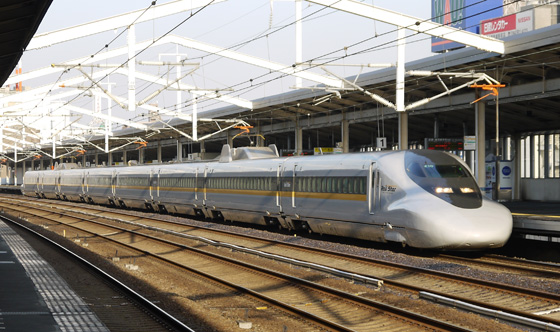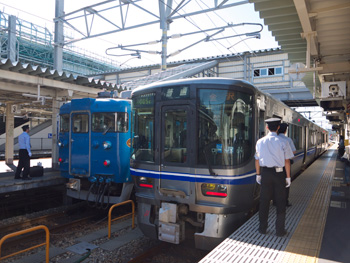Letters from Japan: the Promise of High Speed Rail (original) (raw)
Culture Thu Dec 19 2013
Editor's Note: This is part of an occasional series of columns from former GB contributor Sheila Burt, who lived in Japan for three years before recently returning to Chicagoland. "Letters from Japan" will discuss social and urban issues Chicagoans face and how the Japanese do it differently. Previously: Life in a Japanese School; America & Chicago, as Seen from Japan; Biking in the Countryside and City.
In October, I returned to my home town after living in Japan for three years. While it's been a strange adjustment in a lot of ways, so much about being back in Chicago feels familiar — good pizza, blistering winter weather, the potent urine-stench of certain El trains, and perhaps most evident to me, transportation woes.
Within the first few weeks of my return, I constantly heard not only about the Ventra debacle but also continuing debate about high-speed rail. Having lived in a country that built the world's first high-speed rail line and prides itself on precision in every aspect of life, I say with ease that when it comes to transportation, being in Japan spoiled me.
I lived in quasi-rural Japan without a car, riding my bicycle to and from work and taking the train or bus for longer commutes. I made it a point to explore the country as much as possible, choosing to take a night bus — a bus you sleep on as you travel to your journey overnight — to most places. However, when I could afford it, I rode high-speed trains with eagerness and awe. On my first trip using high-speed rail, I traveled from Tokyo to Kyoto — two of Japan's most popular destinations that are about 275 miles apart — in just over two hours. Despite some heavy rain through part of the journey, the train arrived exactly on schedule without so much a bump in the ride. Although passengers included tourists like myself, the train was also full of business commuters and students who were traveling for the day.

This smooth train ride was not an exception. Japan has one of the world's most extensive high-speed rail networks, reaching all major cities on the mainland and connecting mid-sized cities with important commerce destinations such as Tokyo, Osaka and Nagoya. Spurred by Japan's recovery post-WWII and the 1964 Olympics in Tokyo, the Japanese government began to build a high-speed rail line between Tokyo and Osaka in 1959, though plans for it pre-date WWII. This new "bullet train" — named because of the train's shape — opened in time for the Olympics and linked two of Japan's economic powerhouses, which are about 300 miles apart. The arrival of the Tōkaidō Shinkansen service also cut down travel time to four hours, allowing business passengers to make daytrips more easily between the two cities (previously, without high-speed rail, the journey took around seven hours).
The Japanese government continued to build high-speed rail lines at record levels, and now, hundreds of thousands of people ride one of Japan's shinkansen trains everyday, including business executives traveling for meetings and tourists who often receive discounted prices through a special rail pass. The journey between Tokyo and Osaka now takes just under three hours, and on average, shinkansen trains run at about 163 miles per hour. Precision and safety are key, so average delays clock in at less than one minute. In contrast, Amtrak's Acela Express, the fastest train in North America, travels at 150 mph for only two sections of its route between Boston and New Haven, averaging 135 mph for the rest of the journey.
"When it opened, the shinkansen was heralded as a sign that Japan was back on the international map, a sign that Japan was starting to advance technologically very quickly and modernizing very quickly," says Christopher Hood, author of Shinkansen: From Bullet Train to Symbol of Modern Japan and an long-time researcher of Japanese high-speed rail. "As part of the process of everything else that was going on during this time in terms of having the Olympics and Prime Minister Ikeda's income doubling plan, it just gave the Japanese that little bit of extra swagger and confidence, which clearly they had lost as a result of losing WWII. I think it was very symbolic in that respect."
 Even Japan's non-high speed trains run on a precise schedule with infrequent delays — in my three years there, the only times I remember experiencing some minor delays were due to a large snowstorm and the 2011 earthquake and tsunami.
Even Japan's non-high speed trains run on a precise schedule with infrequent delays — in my three years there, the only times I remember experiencing some minor delays were due to a large snowstorm and the 2011 earthquake and tsunami.
Although the Japanese welcome most new high-speed rail lines, which Hood says are funded through public-private partnerships and generate an operating profit, this support hasn't always been there. Unlike current debates about costs and ridership in America, the Japanese most worried about safety when the first line was built.
"There were concerns about it because the JNR, the railway company, had a very poor safety record," Hood says. "A lot of people thought that it was inevitable that there would be an accident at some point. With so many people on the shinkansen, that would lead to a high level of fatalities. But we're nearly 50 years on and there hasn't been such an accident yet. In the end, the Japanese have been able to take great pride in this very efficient, fast, safe system."
While the Japanese haven't looked back since the first line opened in 1964, the transportation world in Chicago could not be more different from the efficiency I experienced in Japan. Although the CTA has unveiled new trains and recently announced plans to overhaul the Blue Line, I've returned home to face all too familiar dilemmas: frequent delays, inefficient programs and a continuous debate about how and if to improve rail connections in the Midwest.
Most recently, in late September, the Illinois Department of Transportation (IDOT) sponsored a feasibility study to research the cost, effectiveness and impact of a 220-mph high-speed rail service from O'Hare Airport to Urbana-Champaign. The service would continue on to St. Louis and/or Indianapolis. Although estimated to cost between 22billionto22 billion to 22billionto50 billion, the high-speed system would allow passengers to travel from Chicago to Urbana-Champaign in 45 minutes, Chicago to Springfield in an hour and 18 minutes, and to St. Louis and/or Indianapolis in about two hours. In the report, researchers projected that the corridor would attract 8 million to 15 million passengers by 2035, create between 400,000 to 792,000 jobs, increase regional development and reduce traffic congestion on highways and at airports, among other benefits.
When comparing Japan to America, I recognize that Chicago — and the Midwest — is not Japan and will never be. We're ruled by highways, and are less densely populated and much too sprawling to ever compete with the system that operates in major Japanese cities. The more I look at costs and simply our transportation habits as Americans, my idealism and hope about bringing high-speed rail to the U.S. has waned. But being in Japan showed me that having at least some form of high-speed rail is a worthwhile and critical investment, especially between corridors frequented by students, tourists and business professionals.
"People want trains. They want better buses," says Richard Harnish, executive director of the Midwest High Speed Rail Association, a transportation advocacy non-profit established in 1993. "But just like we had a massive government program to build highway infrastructure and to support the auto industry, we have to have the same kind of thing if we're going to have good trains."
Harnish argues that if the U.S. government had invested in high-speed rail at the same rate China has in the past two decades — and spent a fraction of what it does on the military — we'd already have high-speed lines connecting Chicago to New York as well as lines linking smaller Midwest cities, including St. Paul, St. Louis and Cincinnati.
"We're spread out and we've got to get these people closer together. With high-speed rail, you'll create the volumes needed to create a much better local distribution network," Harnish says. "So, first of all, there is still a lot of economic activity downtown, so I am able to, for most of my trips, to take the train. There is the ability to create a distribution network when high-speed rail is in place and actually grow it as the train service grows."
Harnish sees three critical points in order to get some form of high-speed rail moving in the Midwest — upgrading existing Amtrak lines, fixing Union Station and, from there, mapping out four different directions and routes where high-speed rail can grow.
All of this, however, comes at exorbitant costs, as the construction of "true" high speed rail (anything above 150 mph) involves building dedicated infrastructure that doesn't intersect with roads. So far, 110-mph service runs between Dwight and Pontiac, and IDOT officials hope that service will extend to Joliet by 2017. Joseph Shacter, director of public and intermodal transportation at IDOT, says this incremental approach is more realistic and favored by Governor Pat Quinn.
"The feasibility study gave us a good picture of what it will take to get there," Shacter says. "We are excited to get the first phase of higher speed and see how the public responds to that."
Yet even with increased Amtrak ridership in recent years and more attention focused on building high-speed rail, many questions loom about how effective service will be in the Midwest, and if there are better ways to spend federal and taxpayers' dollars.
According to Hood, the expert on Japanese high-speed rail, this watchdog skepticism rarely exists in Japan, and the public supports new train projects with only a few exceptions. Hood also notes that while many countries in Europe and Asia easily embrace high-speed rail, America isn't the only country with resistance. In the U.K., where he is based, similar fears about spiraling costs and low-usage ring loud.
"I think it's always difficult to come to the game late on," he says. "A railway line, once it's built, it's built. And if people don't want to use that line, they're not going to use this line. There's that underlining concern. So you have to choose the right routes when building. In Japan, that's relatively straightforward because most of the major cities are along one coast of Japan, so if you link those cities, then you've probably got a profitable line."
The future of high-speed rail is much less clear here than it will ever be in Japan, but I can't help but want Chicago to get moving on improving city and statewide public transportation. The more I settle back into my hometown, the more I wish the notion of efficient and extensive public transportation isn't just hopeful thinking.
Photos by Sheila Burt
